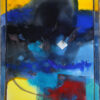Introduction
Arts would not have received a great deal of global attention had it not been for the aesthetic and intellectual values they added to the human existence and civilizations which still take them as a starting point for expressing local identities, and a tributary for highlighting the elements of uniqueness and culture. Perhaps that is what granted the discourse of aesthetics an advanced position within various establishing fields of human sciences. In specific, aesthetics, added to being an epistemological mediator between production and systems of theory and a solid entry to the efficiency of forms and types of reception, is a philosophical and critical reflection on the art preoccupations, forms, and values. It also plays a major role in deepening human’s awareness of being, horizons, and frequent aspirations towards creativity and difference. Therefore, it is not surprising that contemporary aesthetics is a key player in the emergence of postmodernism paradigm which sought, in its philosophical goals, restoring subjectivity, relativizing all reliability absolutes, and transcending the normative and technical postulates that dominated our modern era via legitimizing everything related to uniqueness, diversity, and difference. In this context, we can raise the following questions: i) how did contemporary aesthetics interact with the question of hermeneutics? ii) what is the relationship between contemporary aesthetics and the postmodernism paradigm? and iii) where is the hermeneutic function pertaining to the contemporary visual arts?
On hermeneutics and art: connections and intersections
Primitive arts intersect with hermeneutics in their connection to the fields of theology and myth which surged in many civilizations of the ancient East through sculpture, architecture, and theater as sacred manifestations of the rites of life, and that can be noticed in the Pharaonic, Babylonian, and Greek civilizations. The connotations of art would not have continued had it not been for engaging religious hermeneutics that analyze the world, reveal the transcendent metaphysical hidden connotations, and provide interpretations that bridge the connections between human, theological, mythical, and creative phenomena. Major evidence comes from the Greek civilization which singled out -among its theological myths- special gods for the interpretation of revelation, namely Hermes who took upon himself more than one duty [1]. The most prominent among Hermes’ duties was interpreting gods’ words and transmitting them in an appropriate manner to human understanding. More impressively, the dialogues of Plato and Cratylus made Hermes “the god who invented language and speech.”[2] On the other hand, the etymological origins of Herméneutiques, in terms of an interpretive philosophy concerned with understanding the phenomena of understanding in itself, return back to Hermétisme, which is the first legendary source of such philosophy [3] whose importance emerged in light of postmodernism- the philosophical current that viewed hermeneutics as a subjective mental activity that constantly consolidates difference and calls for uniqueness.
The question of hermeneutics between contemporary arts and aesthetics
Before we begin to clarify the question of hermeneutics within the systems of contemporary aesthetics, it is necessary to refer to the relationship of contemporary visual arts with postmodernism in order to discern the nature of hermeneutics in light of the dialectical interactions it establishes with the previous concepts. In this regard, we can briefly point out that there is a wide gap between fine arts and contemporary visual arts pertaining to the philosophy of production, tools, techniques, media, forms, presentation methods, and marketing. If the fine arts were based on modernist perspectives that believe in technology and encompass limited varieties such as sculpture and painting (realistic, impressionistic, symbolic, or expressive), contemporary visual arts, contrary to the above, oppose all perceptions that confine art to beauty, or seek art for the sake of art. In the aftermath of World War I, the French artist Marcel Duchamp made another turning point in arts, when in 1917, he presented his artwork ‘The Fountain,’ which was a ready-made ‘urinal,’ which, after three decades, brought about a revolution in the mediums often used by fine arts such as clay, paintings, clothing, and dyeing. In other words, art became able to be present in ready-made or popular things. Put differently, the visual arts legitimized the freedom to employ all the materials and mediums that the artist chooses without any restrictions, thus identifying with the starting points of postmodernism which opposes everything that frames art by rules or pushes it into the realities of narrow standards or limited molds. So, how did the need for hermeneutics emerge within the philosophical and artistic traditions of contemporary aesthetics?

2.1. The problem of understanding and possibilities of hermeneutics: from art to aesthetics
It seems that the diversity of visual art materials and forms, along with postmodern legislations, led to a diversity of contemporary artistic genres in a way that undermines all systems and backgrounds that can be adopted as an entry point for generating readings of confusing forms, from the productions of Marcel Duchamp to the murals of Banksy. The viewer faces many artistic genres such as Installation, Performance, L’art Vidéo, Conceptuel Art, Pop Art, Digital Art, Design Art, Contemporary Sculpture, Environmental Art, …etc. This multiplicity implicitly indicates the ‘problem of understanding’ which contemporary aesthetics noticed and attempted to overcome by emphasizing that hermeneutics harbors creative potentials that enrich approaching visual works and reading their types. That comes after the “sight in contemporary art is” found to be “not qualified to distinguish between art and its opposite, in the sense that sight is no longer able to be an aesthetic criterion because aesthetic pleasure is no longer linked to what is artistically beautiful.” [4]
Aesthetics then, as the epistemological and philosophical institution that deals with the theoretical and academic problems of art, deviated to establishing more open and spacious taste of approaching artworks. This is so because “Judgment is no longer a necessary component in the requirements of criticism,” [5] whether the situation is related to understanding the visual or fine arts. Judgment has become a secondary element compared to the open indicative possibilities that are pursued by the paths of hermeneutics, affirming that the aesthetic and philosophical value of contemporary visual arts is too great to be reduced to a judgment and too powerful to be questioned by normative mechanisms whose ultimate concern is the conformity with some theoretical statements. Avoiding exaggeration in objective or value judgments or strictness in the preponderance of rational understanding are no longer of importance with regard to the philosophical dimensions which are used to look into the concept of beauty.
The need for hermeneutics would not have grown had the visual arts not evaded -in light of freedom granted by postmodernism- from the censorship of public taste, the embarrassment of moral and social values, and the tyranny of rational constants. This situation made hermeneutics a starting point for highlighting the value of self-understanding that is estranged from scientific or reliability allegations, just as it made hermeneutics an aperture to enrich an artistic work by ensuring its openness to the dialogues and questions generated by the viewers. In this regard, Gadamer believes that “The experience of an artwork includes understanding in terms of a hermeneutic phenomenon and not in the sense of a scientific method at all” [6] perhaps because art “Does not accept reduction to material reality, nor to any ideology that explains this reality.” [7] On the other hand, it can be said that the experience of comprehension in art assures that “Nothing can remain the same” [8] whether it is a matter of production or reception. This indicates that “Contemporary art discussions -from specialized magazines to press brief columns- comprise respectful hermeneutics and complex philosophical deviations” [9] in which the repercussions and effects of these deviations keep on influencing some creative and intellectual fields.

2.2 Interpretive necessity in the generation of aesthetic knowledge
It seems that the nature of contemporary art, contrasting with the classical traditions which art has perpetuated, made aesthetics incapable of distancing from hermeneutics. Thanks to its broad premises, aesthetics raided the visual properties of touching artworks- those works that chart their unique identity into form, matter, and expression. It has become clear to us that hermeneutics is a necessity for the collection and generation of artistic knowledge as the need for it becomes more urgent as the theoretical concepts’ tools and procedural power become exhausted in tackling new forms and varieties. At this juncture, hermeneutics emerges as another possibility to think about an artistic or human phenomenon without giving much importance to any referential or epistemological frameworks that may affect the path of understanding because the breadth of meaning in art exceeds the narrow curricula and the limitations of tools. In result, hermeneutics turns to an aperture that paves the way to new paths in the production of knowledge from within the works of art, away from critical, scholastic, or epistemological mediations.
Within the framework of hermeneutic necessity, literature and arts have become -in the traditions of contemporary aesthetics- sources for the generation and amalgamation of knowledge. This was highlighted by Mark Jimenez in his work ‘What is Aesthetic?’ in which he argues that arts embrace various aspects of knowledge, and “Habermas does not rule out the possibility that aesthetics may, over time, influence other rationalities […]. In this way, we will end up, in the long run, with reconciliation between all aspects of reason;” [10] that is, avoiding the tensions that distance science and art as the latter -art- “lends an image to the world of possibilities within our feelings. In this sense, art is said to be creative” [11]. However, the feature of creativity pauses whenever comprehension is confused, or access to the value and indicative essence is difficult, which leads the goal of generating artistic knowledge to confess the need to hermeneutics which is not confined to stereotypical stalemate and stillness. Although hermeneutics may lead us to an inflation of readings or to the emergence of ideological projections that are nonconforming with the characteristics of the works, hermeneutics remains closely connected to the effective movement and critical flexibility, which would enrich the works indicatively, cognitively, and artistically.
There is no doubt that the value of arts is not determined by the form they reflect although it is an important element, but their value is related to the aesthetic or intellectual echoes and representations they evoke in the human conscience. In this context, the importance of hermeneutics is confirmed within the discourse of contemporary aesthetics in that it is an authentic distribution towards the democratization of understanding whenever viewers find themselves forced to express their subjectivity and visions, and whenever works resist being understood, or their representation remains a matter of confusion. Therefore, the hermeneutic necessity becomes a bridge to help “and share what is missing with public.” [12] That is, it helps defeat what is difficult to understand directly about a work of art like its indicative implications or lost meanings which require implementing hermeneutics and avoiding stereotypical rumination in order to create new knowledge and innovate deep ideas that enrich the work’s identity, openness, and expansion. “Arts today are without a subject” [13] not because they lack values, ideas, aspirations, or social and cultural issues but rather because their subject matters are left open for disagreement and hermeneutics.
Synthesis
Finally, it can be said that contemporary aesthetics were able, thanks to postmodernism and its requirements, to transcend the restrictions of monolithic reading and criticism in the fine arts that relied on the technique, tools, and standards adopted by classical or modern schools. Such transgression would not have been achieved had it not been for resorting to openness, the dialogue that was forcedly imposed by varieties of contemporary arts, and the contemporary art forms that have always expressed difference pertaining to production and reception. We can consider these interactions among the highest justifications that prompted contemporary aesthetics to reconnect their epistemological relations with the question of hermeneutics and to view it as a systematic aperture disassociated from any higher reliability controls that may hinder achieving the goals of democratizing comprehension. The evocation of the hermeneutic necessity comes not to outweigh one understanding over another, nor to claim that it is the best approach to delve into works or question them, but rather to legitimize subjectivity in comprehension, enrich difference, and confirm that freedom of creativity needs to have freedom of reading. As such, hermeneutics turn to be a perpetual epistemological narrative with continuous renewal and diversity by virtue of its attributive nature that does not claim perfection regarding the effects resulting from readings and hermeneutics.
In conclusion, some may accuse the hermeneutics in contemporary aesthetics of (reading) inflation which leads comprehension of arts to nothingness. Such accusation may prima facie seem legitimate, but it should be noted that literary and visual arts cannot live and their indications do not flourish sans the multiplication of readings and the diversity of interpretations and hermeneutics.
Bibliography
1 – The myth of Hermes is one of the most prominent Greek myths in terms of combining complex contradictions. In addition to conveying and interpreting the words of gods, Hermes represented “The god of commerce, livestock, and travelers, and then he became the god of weights and scales, their protector, the guardian angel of embezzlers and thieves, and the patron and supporter of athletes.” Look:
– Hassan Nehme: Mythology and Myths of Ancient Peoples, Encyclopedia of Monotheistic and Non-heavenly Religions, Dar Al-Fikr Al-Lubnani, Beirut, 1st edition, 1994. p. 293.
2 – Plato: The Dialogue of Cratylus in the Philosophy of Language. Translated and presented in an analytical study by Azmi Taha Al-Sayyid Ahmed, Ministry of Culture, Amman, 1st edition, 1995, p. 42, adapted.
3 – The Tunisian thinker Fathi Al-Maskini elaborated on the origins of hermeneutics within the Greek cultural traditions, confirming that it descends from “the Greek verb ‘Hermeneuein’ (ερμηνευειν), which refers to three meanings: a) expressing an idea through speech, b) defining, referring to, and showing something, and c) interpreting and translating. In similar lines, ‘hermeneia’ (Ερμηνεία) means ‘phrase,’ and it is the title of one of Aristotle’s logic books ‘Peri hermemeia’ which was translated by Arabs ‘On the phrase.’ Similar meanings that belong to the lexical interpretation of ‘hermeneia’ are the interpretation and clarification of a thought. The word ‘Permenes’ (Ερμηνευϛ) refers to the one who does the interpretation, the clarification, or the translation. Look:
– Fathi Al-Maskini: “How did hermeneutics become a philosophy? An Introduction to the Question of Understanding,” Philosophy of Interpretation: Labor, Establishment, and Transformations (a co-authored book), supervised and edited by: Ali Abboud Al-Mahmadawi and Ismail Mehnana, Ibn Al-Nadim Publishing, Beirut, 1st edition, 2013. p. 13, adapted.
4 – Haiba Masoudi: “The Crisis of Contemporary Art between Concealment of Meaning and the Necessity of Interpretation,” The Interpretation of Science and the Interpretation of Art (co-authored book), coordinated by: Mohamed Al-Hirish, Publications of the Laboratory of Interpretations and Textual and Linguistic Studies, Faculty of Arts and Humanities in Tatouan, Bab Al-Hikma Publications, Tatouan, 1st edition, 2022. p. 374.
5 – Terry Michael Barrett: Why is that art? aesthetics and criticism of contemporary art, Oxford University Press, New York, 2017. p.10.


6 – Hans-Georg Gadamer: Truth and Method: Basic Lines of Philosophical Interpretation, translated by: Hassan Nazem and Ali Hakim Saleh, reviewed by: Georges Katoura, Oea Publishing House, Tripoli, 1st Edition, 2007. p. 169, adapted.
7 – Saeed Tawfiq: The Interpretation of Art and Religion, The Egyptian Lebanese Publishing House, Cairo, 1st Edition, 2017. p. 18
8 – Monique Disco: Plato…the Desire to Understand, reference mentioned. p. 141-142.
9 – Julian Stallabrass: Contemporary Art: A Very Short Introduction, translated by: Marwa Abdel Fattah Shehata, reviewed by: Dia Warrad, Hindawi Foundation for Education and Culture, Cairo, 2014. p. 11.
10 – Marc Jimenez (quoted): What is Aesthetic, translated by: Charbel Dagher, The Arab Organization for Translation, Beirut, 1st edition, 2009. p. 407, adapted.
11 – Jalal al-Din Said: Lexicon of Philosophical Terms and Evidence, Dar al-Janoub Publishing House, Tunis, 1st Edition, 2004. p. 346.
12 – Terry Michael Barrett, Ibid. p. 6.
13 – Al-Saeed Labib: “On the Interpretation of the Artistic Work,” The Interpretation of Science and the Interpretation of Art, coordinated by: Muhammad Al-Hirish, reference mentioned. p. 357.
Moroccan researcher prepares hermeneutics dissertation at the Center for Doctoral Studies in Literature, Humanities and Translation (Abdelmalek Saadi University/Tétouan). He has won the Sharjah Arab Creativity Award from the Department of Sharjah Culture and the Takween Award from Arab Readers.He published Interpretive Representations of History in Arabic Fiction at the Department of Sharjah in 2019, as well as several studies and articles in professional journals.






